Not Forgetting - Chapter 3, part 3: Queen Street and Chapel Street
David Middleton and Sue Middleton
The 20th Century saw Queen Street develop into the main commercial focus of the village. Whilst there are still a number of residential properties, a significant number of buildings have, at one time or another, been put to commercial use during the last 120 years.
Queen Street, Shops and Trades – 1851 census
Although this chapter is concerned mainly with shops and trades in Bottesford during the 20th Century, it is worth looking first at the profusion and variety during the preceding century. The census made in 1851 revealed the growing vitality of the local economy with the arrival of the Railway in the mid 19th Century. Twenty six households were recorded in Queen Street.
There were a number of trades-people who had occupations connected with the building industry – three bricklayers, two brick-makers, a tile-maker, and a master carpenter with three apprentices.
Agriculture in Bottesford was supported by William Spencer, a master wheelwright; James Morgan, a farrier; Richard Challands, a master harness-maker and his apprentice Robt. Mills; Joseph Wilkinson, a master blacksmith and his son Frederick, an apprentice blacksmith and his nephew Tobias, a journeyman blacksmith. Thomas Branby (born in Melton Mowbray) was a master rope-maker. John Longbottom was a journeyman miller from Claypole so it is likely that the windmill on Queen Street was operating then.
A number of women were employed in cottage industries adding to family income and domestic labour. They included: lace-runners; charwomen, housekeepers; house servants; shoe- and boot-binders (who were employed by a shoemaker).
There were also the trades that supported Bottesford’s self-sufficiency in clothing. A master tailor (William Lee from Bury St. Edmunds) lodged at the Granby Arms (landlord Robert Marriott); a dressmaker (Sarah Carter) and a straw bonnet maker (Ellen Bend) provided fashion for the ladies of Bottesford. A hairdresser (Robert G. Bradley) was also listed in Queen Street. However it is not known whether this was for both men and women.
The building of the railway line and commencement of regular services between Nottingham and Grantham provided further employment opportunities. John Dyer, a railway platelayer from Weeting, Norfolk, came to live in Queen Street.
Elizabeth Musson (from Southwark) had a grocer’s shop in Queen Street but there is no record of its position and Robert Marriott was the innkeeper at the ‘Granby Arms’ who also took in lodgers.
John Hiffe was the police constable at the police house and Miss Sarah Pycroft, a schoolmistress, lived with her aunt Mrs Mary Layfield.
More unusual was the trade of John F. Hudson who was a master chair manufacturer from Louth.
Western side of Queen Street, from the High Street
No.1 Queen Street
No. 1 Queen Street (1st left in the early 1900s photograph) was converted to double-fronted commercial premises in the early 1970s. Today it is a veterinary surgery. Before adaptation to that use in the 1980s, various businesses had occupied the premises including: a printer, Skidmore’s Trains and Model shop, Alan Palmer’s electrical goods and services and Holland Bros. Hardware Store.
Moving up the street, between what is now the vet’s and the fish and chip shop, there were double gates which allowed carts to enter the yard in front of the barn, built in 1849 by W.W. – probably William Wilkinson (wheelwright and blacksmith) who lived opposite at No. 8 Queen Street in 1880.
The barn was converted in the 1970s for commercial use and currently is a hairdressing salon (Mrs Rosemary Baxter). However, it has also had a gentlemen’s hairdresser downstairs (Mr Brian Towsey) and a printer upstairs (Mr Harris, father of the novelist Robert Harris). When Mr Harris relocated his business the upper floor became an electrician’s premises (Mr Alan Palmer).
Fish and Chip Shop (11)
Mr Ken Greasley built ‘The Bottesford Fish Bar’ in the mid 1960s following demolition of a double fronted house, which had itself been built in the 1920s on the site of an older cottage. Originally owned by Mr and Mrs Tom Jackson, the fish and chip shop was then taken over by ‘Connie’. Her rare pale blue convertible Ford Capri was much admired by customers. Mr and Mrs Tommy Cheung then ran the business for a short time before Danny and Christine Cheung became the proprietors in the early 1980s. Christine Cheung also recalls that, “someone called Wendy ran the shop immediately after Connie.” The building was extended again in the 1980s to provide living accommodation above.
Next door to the Fish and Chip Bar is a cottage that is at present two flats. It was originally a cottage with cowsheds at the rear. W.J. Roberts converted these buildings into commercial premises with a flat above in the late 1970s. Businesses run in these premises have included a video shop, Ian Kitchener’s television and electrical repair business, and a paper shop.
Likewise No.7, now Victoria Cottage, has been both a residence and commercial premises. A cobbler, Mr Hartley James, worked here: it is remembered that “he and his wife sold lovely shoes and Mrs James also made beautiful paper flowers.” After the end of the Second World War, Mr Walter Herbert Greaves moved his cycle repair business at this address, having previously been in a wooden shed by the ford on Rectory Lane (which became an electrical supplies shop, re-charging radio accumulators, run by his son, Albert Greaves). One local resident recalls that Mr Greaves “was noted for doing his best to keep the village bicycles in good repair even when spares were in short supply. One young lady of the village was very upset to find that her new tyre did not match the colour of the other one!” In the 1980s Mr and Mrs Alan Millership opened a shop here called ‘Hobson’s Choice’ selling ‘on the shelf’’ medicines and fancy goods. In the early 1990s the business moved into the Old Telephone Exchange on Market Street and No.7 was converted back to residential use.
Bottesford Co-op (12)
The current Co-op and accommodation, built in the 1960s, is on the site of the second Co-operative shop to be opened in the village. The first was opened in the late 1800s on the eastern corner of Queen Street and Chapel Street, in part of Mr Lane’s house (for further details see ‘A Little History of Bottesford’). After it closed, the Grantham Equitable Co-operative Industrial Society opened on the present site in Queen Street.
This second Co-op is remembered in the late 1920s as having drapery, haberdashery and shoes on the left hand side of the entrance and provisions on the right-hand side. The door just visible to the left of the photograph was the entrance to the ‘Manager’s house’ where sign-writer Louis Abbott lived from the 1930s to 1950s.
There was a two-storey building to its rear. The ground floor was for storage, but the first floor was used as a Pentecostal Church Sunday School (The Sunshine Corner) and also for dancing lessons.
Gregg’s Shop (13)
The single storey building known as ‘Gregg’s Shop’ is seen in the photograph of buildings demolished in 1959. Kelly’s directories for 1928 and 1932 list Mrs Ada Gregg as a glass and china dealer. The 1941 entry lists her as ‘ironmonger’. ‘Gregg’s Shop’ also sold papers; local people remember Mrs Gregg delivering papers in all weathers on her bicycle.
Another person associated with this shop was known as ‘Tinman’ Briggs. Frank Briggs is recorded as a ‘tinsmith’ and ‘crockery and hardware dealer’ from 1899 until 1925. It also remembered that Mr Wing, who was both a cobbler and postman, rented these premises at one time. He appears to have moved his business around the village using a variety of premises on both Queen Street and the High Street.
Queen Street Mill (14)
A 19th Century photograph shown in Chapter 8 shows that there was a windmill on Queen Street. The picture also shows an adjacent chimney stack, which may well have been built as part of a conversion of the mill site to steam power. However, there is no record of when the windmill was demolished.
Now converted into flats, the building formerly known as ‘The Mill House’ can be seen to be in front of the windmill in this early photograph. In Wright’s Directory of 1899 a miller named Richard Ernest Robinson was listed. The butcher, John Daybell Robinson also lived in the Mill House before he moved to his new premises on Market Street in about 1900.
In the period 1920/1930, the Mill House was the home of managers of the Bottesford Steam Laundry, which was located in buildings to the rear. The proprietors in 1928 were J.B. and F. Bullimore, then in 1932 the proprietor was Mrs D. Manchester (Mr and Mrs Bullimore’s daughter). It is remembered that Mrs Bullimore, after much effort, eventually managed to win the laundry contract at Belvoir Castle. Mrs Palmer, Mrs W.J. Roberts (Joan Tuckwood), Violet Taplin and Mrs Marston (the wife of Arthur Marston) were employed as flat ironers at the laundry, working in a glass-covered veranda attached to the laundry.
Winn’s Shop (15)
No.39, the last house on the corner of Queen Street and Chapel Street, was the location of F.A. Winn’s Shop. In the census of 1901, and Kelly’s directories of 1908 and 1916, Samuel Winn (1866-1932) is named as a grocer or a general store keeper. In subsequent directories, Mrs Florence A. Winn is recorded as selling groceries. The shop was taken over by Miss Rayner and Miss Wells after the deaths of Mrs Winn and her daughter. Miss Rayner and Miss Wells sold groceries and draper’s goods.
Philip and Rosemary Gibson bought the business from Miss Rayner in May 1965 and opened for business on Thursday, 6th May 1965. They sold all grocery items, plus bread, milk and vegetables (until Sid’s greengrocery business opened opposite the Coop store), also sweets etc.They sold cigarettes and tobacco, which was weighted out on small scales with brass weights of 1/4 oz, 1/2 oz and 1 oz. They also had a counter from which they sold Wendy Knitting Wools and patterns, children and baby wear, and small toys. They were open from 8.30 am to 5 pm, Monday to Saturday, with half day closing at 1 pm on Wednesdays. The Gibsons dealt with Parker’s (Wholesalers) in Grantham for grocery items, and most Wednesdays after closing they would take the train from Bottesford Station to Nottingham to purchase and order items from W.H. Smith, who sold most items, and also from a wholesaler named Riddel’s to order baby/children’s clothes and toys.
Mrs Gibson recalled how she really enjoyed cleaning the large window at the front of the shop and re-dressing it wool, clothes, toys etc. every Monday. The small window at the side of the shop was for a few grocery items. She added that the General Rate and Water Charges for the Rural District of Melton and Belvoir from the 1st April 1967 to 31st March 1968 was eleven shillings and two pence in the pound.
The Gibsons sold the business due to the ending of their connection to the RAF and having to move to be near to Heathrow. It was sold very quickly to Mr and Mrs Veitch on the 15th August 1967, but it seems they may not have been there very long. The premises have recently (2008) been converted back to commercial use with the opening of an art and contemporary design gallery.
The single-story building to the left was originally a store room and cottage. Converted in the 1970s into a kitchen design studio, it then became a ladies’ wear boutique before re-conversion to residential use.
(We are grateful to Philip and Rosemary Gibson for providing us with their memories of their time in No.39.)
The eastern side of Queen St, from the High Street
The first cottage next to the rear of the ‘Rutland Arms’, No.2 Queen Street, was a derelict house for many years until the early 1980s. After renovation it became an antiques and bric-a-brac shop called ‘Number Two’ – the sign in the window light is still in place though it has now reverted to residential use.
The Marquis of Granby (16)
Next door, No.4 Queen Street, is the former ‘The Marquis of Granby’, called the ‘Granby and Railway’ during the First World War, one of the five known pubs in the village. After the licence was revoked in 1921, it became a residential property. Records of publicans included David Hoe (1841), Robert Marriott (1851, 1885), Samuel Hall (1861), Joseph Johnson (1862), Thomas Redford (1876, 1901), Mrs Ann George (1891, 1895) and Harry Smith (1912, 1916).
Midland Bank (17)
For over 70 years, from the late 1920s until the 1990s, Bottesford had two banks. One of these, the Midland Bank, was in the single story building next to what is now the Malt House Deli. A 1932 directory states that this sub-branch was open on Tuesday and Friday from 10.45am to 12.45 pm. There are no records to show how old the building is or any use prior to 1932. When the Midland Bank provided a mobile service instead, the building became the Bottesford Parish Room and then in turn became a shop selling casual clothes, The Curiosity Cabin, a furnishing fabrics shop, a dried flowers shop and a room used by the Baptist Chapel. For a short time in 2008 it was a flower, plant and seed shop, ‘The Potting Shed’ before its recent conversion to a hair salon.
Frank Miller – Grocery (18)
In the 19th Century, the Malt House Deli was a malt-house associated with the Bull Inn. Before World War 2, Mr Frank Miller had a grocery business there. During the war, the Home Guard and the A.R.P.C. were stationed upstairs. In the 1960s, Mr Freeman Brown opened in it an outlet for his Foston-based bakery. From the 1980s until the early 2000s, Jean and Ian Markham ran ‘Jean’s Bakery’ selling bakery goods and groceries, the bread and cakes initially supplied by Freeman Brown. When he retired, Gadsby’s of Southwell supplied the shop. The building has recently undergone further conversion of the first floor into a beauty and hair salon.
In the photograph, the vehicle outside belongs to Hopkinson, antique dealers in Grantham. Perhaps there was a delivery or collection of goods from Golding of Grantham. This firm held auctions on Thursdays in the Bull Yard covered market during the thirties.
Sid’s (19)
The single storey shop, No.14 Queen St, has been the greengrocery run by Sid and Jean Culpin and their family since August 1965. The building, constructed in 1892, has been used for a variety of purposes. Golding, the auctioneers, had an office there for the Bull Yard market. It is remembered that a hair dresser worked there. Mr Wing, a cobbler (boots and shoes), used it as a workshop in 1941, and lived in the house next door, No.16. During World War 2, the building became an office for the Air Raid Wardens and Home Guard. Later, before the present-day Bottesford Fish Bar was built across the road, and before its current use as a green-grocer’s, Mr and Mrs T. Jackson ran a fish and chip shop there.
Cobblers and leather goods (20)
Beyond the entrance to the Police station yard is a walled garden. The brick out-building shown in the photograph, now demolished, was used as a workshop in the 1950s by Harry Grant, a shoe repairer/engineer, and then in the 1930s and 1940s by Mr Taplin for leather and shoe repairs. The picture also shows an 18th Century house which has now been converted into maisonettes. The building is thought to have been a saddler’s home during Victorian times. There are still hooks for hanging horse harnesses in the building. In the 1901 census, Joseph W. Hudson lived in Queen Street and he was a saddler by trade.
Taplin’s fish shop (21)
The cottage and wooden hut in the picture were demolished and replaced by a modern house in the 1960s. During the 1920s and 1930s, the cottage belonged to Mr and Mrs Taplin. They sold wet fish and ran a fish and chip shop in two wooden huts. The end wall of one hut can be seen on the left of the photograph. The fish and chips were cooked on a stove, using anthracite, in one of the huts and the second provided a waiting room furnished with chairs. A serving hatch connected the two huts.
General Store (22)
Finally, the property at the top right hand corner of Queen Street has had a variety of commercial uses. According to ‘The Little History of Bottesford’ it is where William Billings Lane had his bakery in 1899. He also rented out two front rooms to the Grantham Co-operative Society, which used them as a shop before the Co-op became established at its present site. Mr Lane moved to the corner of Devon Lane and J.D. Robinson took over the premises for a short time before moving his business to Market Street around 1900, after which the shop had a number of occupants.
Older residents recall that Arthur Germany, a baker and grocer, used the ovens left by Mr Lane and also sold knitting wool. Other trades-people in this shop included Mrs. Welbo(u)rne (shopkeeper, wife of the parish clerk), Kath Randall (well remembered for being able to find items in a shop crammed to the ceiling with goods), Rosie Dyer (general store), Joy Taylor (antiques) and, in the 1980s, Mrs Durrant (flowers, plants, fruit and greengrocery). This large house was then modernised and converted into two dwellings. The original bakery ovens are intact though covered with plasterboard, and there is still stabling for a pony at the rear.
Chapel Street
The western end of Chapel Street was a lane through to Albert Street before the houses on The Square were built after World War 2. The Square was built on a paddock where the horses and carts belonging to the bakery of J.D. Phillips were kept. Victor Marston (son of Arthur Marston) remembers that when his mother was working at the Bottesford laundry in Queen Street, washing would be laid out to dry here on the grass and bushes as far down as the River Devon.
There were three businesses of significance whose premises were on Chapel Street.
The Bakery (23)
On the north side of Chapel Street, at the corner of Devon Lane, is the house known as The Old Bakery. According to ‘A Little History of Bottesford’ the building became a bakery when William Billings Lane moved his bakery there from the corner of Chapel Street and Queen Street. The previous owner of the property had been a Mr Fisher, who owned a horse and wagonette business.
William Billings Lane died in July 1900. In the 1901 census, a baker from Nottingham, named Everitt Atkin, was working at premises in Chapel Street. The bakery on the corner was taken over by John Henry Phillips who was baking bread, pork pies, and Christmas cakes in 1908. He was also willing to bake foods brought to the bakery by villagers. Mr Cecil Briggs, who lived on The Green, worked as a baker for Mr Phillips in the late 1920s.
Mr Phillips was still recorded as a baker in a directory of 1941, but by 1946 the Simpson family from Cropwell Bishop had taken over. Thomas F. Simpson was a master baker. He decided that the old domed oven (shaped like a cupola) should be replaced by double-decked steam piped ovens, fuelled by coke from the Bottesford gas works. A Mr Elliott managed the bakery until 1948 and Cecil Briggs continued to bake there. Other members of the staff included Win Claricoates, Herbert Turner, Kathleen Langton and Emily Rayson.
The bakery closed in 1953. During the war, there had been a subsidy on bread but when the subsidy was withdrawn in 1953 (meaning that the price of bread rose from four and a half old pence to seven and a half old pence), it was not possible to sell bread at a competitive price. Mr and Mrs T. Simpson stayed at The Old Bakery in Chapel Street until 1974 and then the building was sold, becoming a residential property.
Singleton’s Farm (24)
Joseph Singleton is entered in directories as a farmer and as a trap proprietor on Chapel Street, living in the large house known as Singleton’s House, (demolished circa 1955). The Singletons were recorded as cab and fly proprietors in later directory entries, when the business passed to Alfred and George Singleton. The broughams, wagonettes and flies for the carrier’s business were parked on land to the rear of the property. When Bottesford railway station was advertised as ‘Bottesford for Belvoir’, a cab and landau service provided transportation to the Peacock Hotel at Belvoir. However, by 1936 Alfred Singleton’s entry was simply a farmer. Perhaps the advent of more motor vehicles on the road had made horse traffic unprofitable.
Watchorn’s Shop (25)
In the 1960s, Mr and Mrs Watchorn converted two cottages on the southern side of Chapel Street into a shop. It had two shop windows, one flat and one bay window. On the right hand side as you walked in there were displays of everything to do with handicrafts, and in particular wools for knitting. Mrs Watchorn was an expert knitter and knitted for people in the village. On the other side of the shop were sweets and groceries.

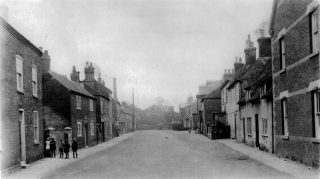
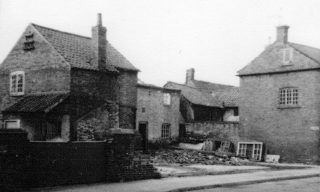
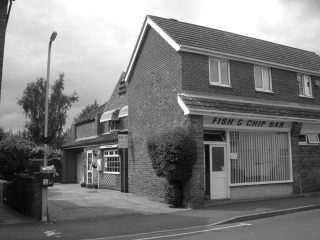
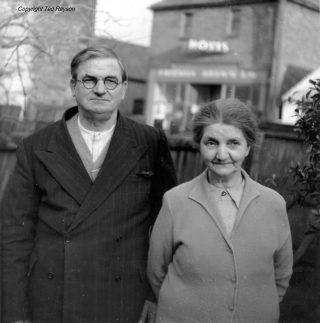
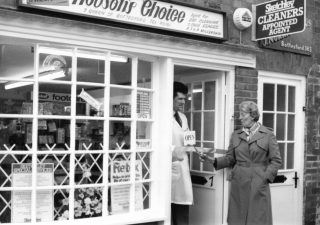
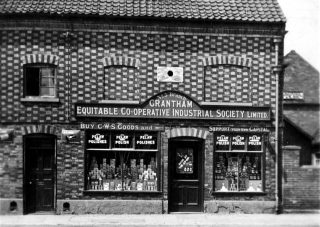
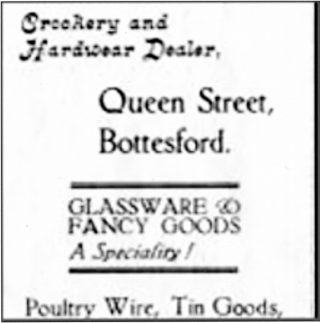
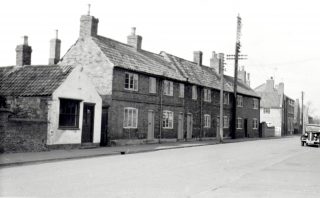
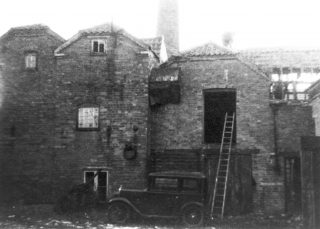
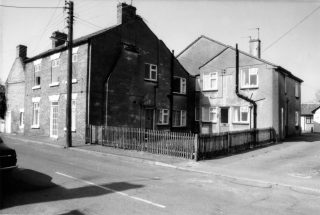
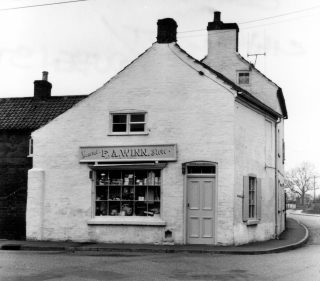
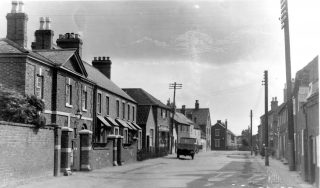
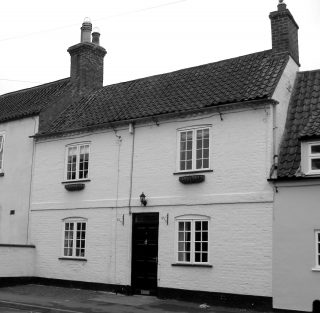
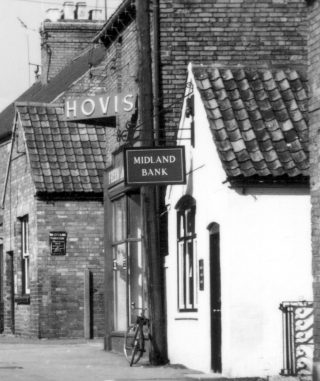
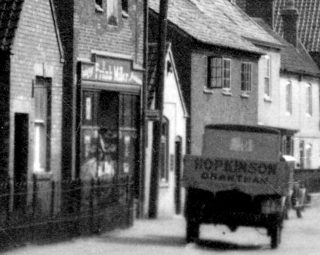
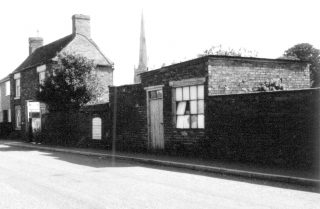
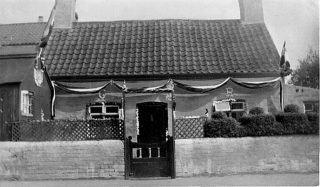
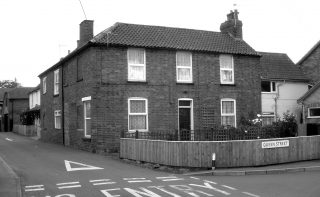
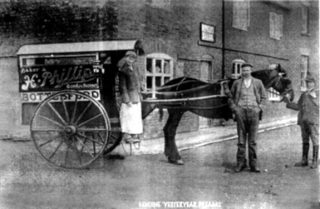
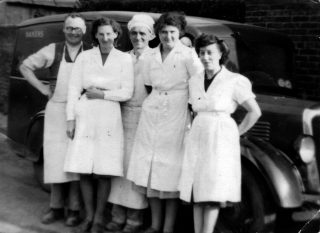
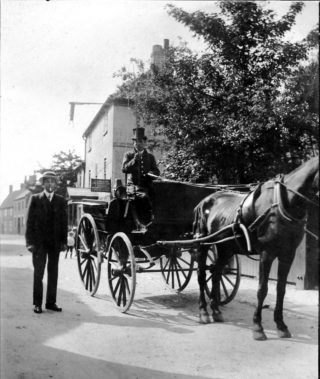
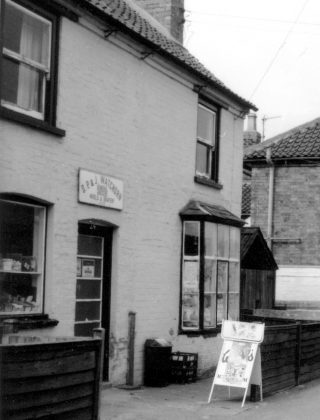








No Comments
Add a comment about this page